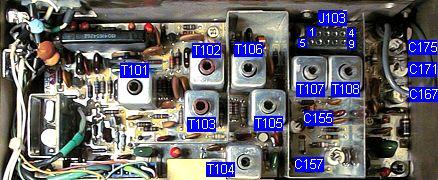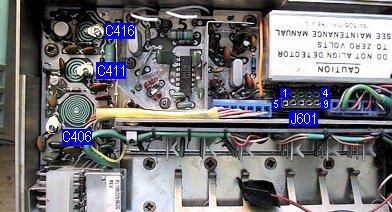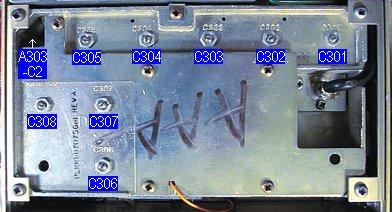Back to Home
By Bob Dengler NO6B
Photos by the author.

|
Up one level Back to Home |
UHF G.E. Custom MVP Tuning Instructions By Bob Dengler NO6B Photos by the author. |

|
Retuning the radio
Here is the basic tuneup procedure as paraphrased from the G.E.
manual along with my own comments based on experience in tuning up dozens
of these radios. Make sure you key the transmitter, tune the indicated
coil or capacitor quickly, then unkey (don't leave the transmitter keyed
for the entire procedure).
Transmitter:
|
 Exciter board tuning locations |
At this point the manual says to basically repeat the steps above shaded in green. I find this unnecessary, but if you really want every stage peaked to the last millivolt, go ahead.
Receiver:
|
  |
Steps shaded in green are performed with a 50 ohm signal generator connected to the radio's antenna input. If you aren't sure about the output impedance of your signal source, just use a 6 dB or greater 50 ohm pad on the output. Due to the tremendous selectivity of the helical resonators, you will probably need a lot of signal at first (millivolts). If you have trouble detecting a signal to tune up on, first make sure your crystal isn't way off frequency by moving the sig. gen. +/- 30 kHz or so off of your center frequency. Then try presetting C301-5 to within about 2 turns of bottom, as this is near the resonance point for the 440-450 MHz range. If that doesn't work you can try injecting signal through the little holes in the helical assembly provided for just this purpose (the manual recommends using them but I find them unnecessary). Steps shaded in blue are done with a full-quieting 1 kHz modulated signal at 3 kHz deviation. If you don't have access to an FM sig. gen. you can adjust L603 by transmitting a DTMF tone with another radio. When you're finished tuning you should get 0.35 microvolts or better for 12 dB SINAD, or 0.5 microvolts for 20 dB quieting. These instructions assume your radio does not have the UHS bipolar preamp. If it does have it I recommend you bypass it & get yourself a good stable GaAsFET or MOSFET amplifier from Angle Linear unless you're REALLY trying to pinch pennies. The UHS preamp does work, but it's noise figure is going to be around 4.5 dB plus I've noticed problems with RF coupling to the outside of the coax leading into the preamp. This can lead to internal desense problems. Also bipolar preamps are known for having a lower 1 dB compression point than the FET amps, meaning you'll be more susceptable to IMD.
Back to the top of the page
Up one level
Back to Home
Article and photos by Bob Dengler NO6B © Copyright October 2001.
HTML © Copyright March 23, 2010 Kevin K. Custer, W3KKC All Rights Reserved.
This web page, this web site, the information presented in and on its pages and in these modifications and conversions is © Copyrighted 1995 and (date of last update) by Kevin Custer W3KKC and multiple originating authors. All Rights Reserved, including that of paper and web publication elsewhere.